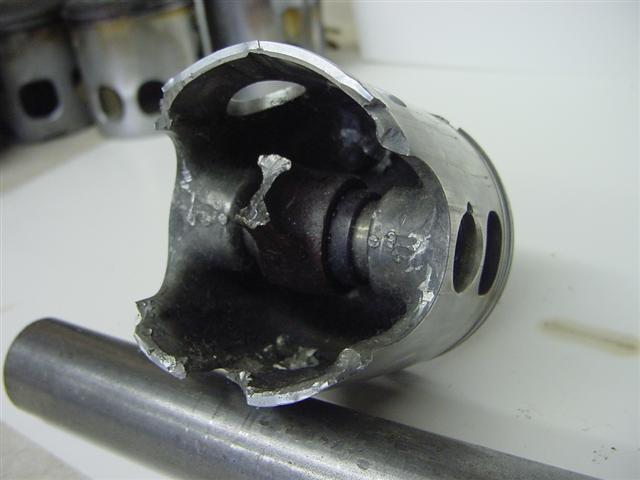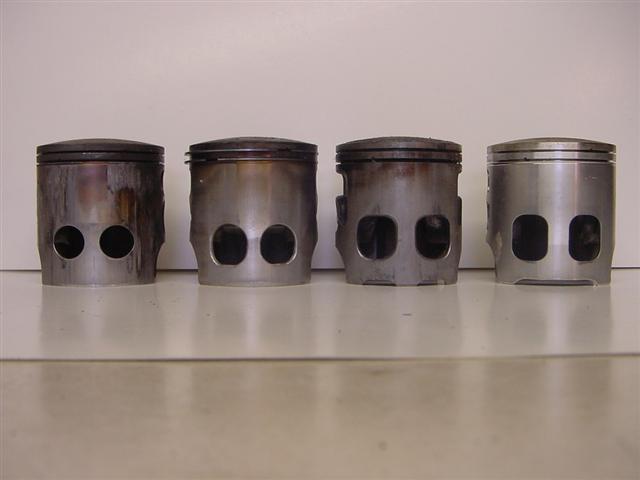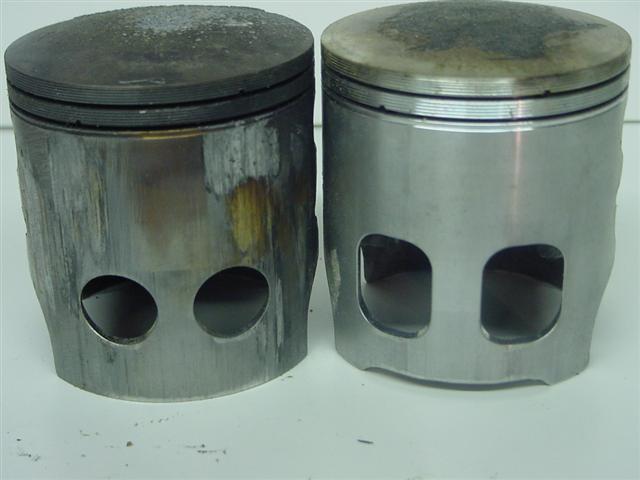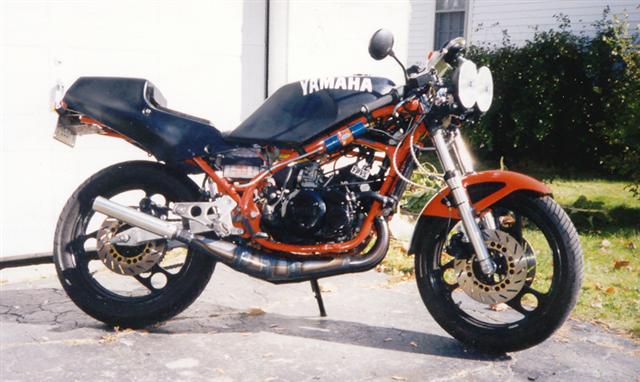

Our garage gang at NHIS. From the left; Pete Furkey, Bill Blythe, Rich Barger, Lyn Garland.
Our all Yamaha garage was made up of their beautifully kept TD and TR's and our mongrel RD.
© Geoff Battick
Cranks: I do not rebuild cranks (yet, the press has just arrived) so in the past I have used Spec II for this and had great results. Find a reputable crank builder, and ask what, if any, special parts they recommend for your application. Full race motors can gain reliability with the use of TZ big end bearings, and you can use TZ main bearings too, but most people do not recommend them on the primary side of the crank, since they do not like the side thrust that the standard RD primary gear creates.
See Lyn Garlands FAQ on this Site for more on this subject
You can have the crank pins welded, which prevents the flywheels from doing any funny shifting at high rpms, but it can make crank dis-assembly a bear. Get the rods with the slots on the big ends. You used to have to order TZ rods, but the last time I saw a set of RD rods they had the slot too, but check with your supplier to be sure, parts change for no apparent reason. See Lyn Garlands FAQ on this Site for more on this subject
If you use lots of oil (20:1) and use a reasonable redline (10.5K, but not every shift) a well built crank will last several seasons easily. The crank is really an important part, so try not to skimp here. I've used old street cranks in a pinch, you know, one week to the season opener and you never got around to sending a crank out last fall after you blew up at the last race, and I have gotten away with it ( again, lots of oil and 10k shift point) but I keep an eye on it and I worry a lot.
If you do happen to suffer a broken piston for any reason, give the rod on that side of the crank a very thorough inspection for any nicks or dings that were not there to begin with. These will rapidly become larger if ignored and sooner or later the rod will break right at that point. The rod in that picture of me with the blown up cylinder suffered a small ding (that's a technical term you know) during that mess.
I chose to ignore it, due to budget restraints, and it lasted through Daytona the next Spring and the Saturday of the first race weekend at NHIS but it decided it had had enough and snapped in two that Sunday during a race. Guess it had suffered enough. I gambled and it only paid off for a short time. It ended up costing me a cylinder, piston, head, cases and crank, along with a race. So you've been warned.

This is that piston along with what remained of the little end of the rod, still attached to the wrist pin. As you can see, the rest of the rod flailed around and destroyed the piston, cylinder, reed cage, cases, and the crank on that side. The bottom of the piston skirt was distorted by the blows and caught and stuck firmly in the intake port about half way through its travel. I had to use a block of wood and a large hammer to drive it out of the cylinder. One of the worst consequences of a blow up like this is then having to port another cylinder to match the remaining one if you are happy with that set.

L-R: (all Wiseco) RD, modded RD, RZ, RZ with centre tang removed

Close up of Wiseco RD and RZ pistons. The difference in the intake holes in the skirt are obvious. OEM parts look like this as well. The RZ part has had the centre tang removed from the bottom of the skirt. The RZ has a bridged intake port that the missing tang rides on. The RD does not have this and if you do not remove that tang you will suffer a catastrophic failure very soon. I've seen it happen.
Another hot topic(ha-ha). Heat IS the enemy. Clearances and bore condition are critical. Each piston manufacturer supplies a clearance spec for new piston, and that is generally a good starting point. Engine builders often have their own pet numbers to use with the pistons they use too. In effort to avoid the old cast vs. forged debate, I'll just say that I have had the best results with OEM Yam pistons, and Pro-X parts as well.
Yamaha calls for .0014-.0016", and on a race engine it's (I think) a good idea to increase that clearance to .0018", since you'll be putting much more heat into that piston than the designer of the RD anticipated. I also use RZ pistons instead of the RD items, as the RZ parts have much larger windows in the skirts saving me the trouble of enlarging the RD style holes myself. BUT! you MUST remove the centre tang form the skirt on the RZ pistons or you will suffer piston breakage! I've seen it, and it is not pretty
. I also chamfer the entire bottom edge of the piston skirt, which I think helps aid oil retention. I also make sure the wrist pin is an easy fit in the piston, which makes removal easier later on. Install the inner circlip first, while the piston is still on the bench, and leave it installed when you remove the piston later, since you only need to remove the outer clip to remove the piston.
You must set ring gap to the manufacturers spec as well. Be sure to de-burr the ends of the rings once this is done, or you will see scoring on the cylinder liner as soon as the engine is run. Air-cooled two strokes like these need a good warm-up before you flog them seriously or you risk a seizure on the first lap if you're a hard charger from the drop of the flag. Yes, I know, too hot cuts power, but I'm not talking about that much of a warm-up.
Clutch and Transmission : I like to use an extra plate clutch kit, like those from Barnett or SpecII. Heavy springs not needed on a street bike unless you get clutch slippage (make sure it is adjusted correctly) but are a good idea on a racer, just be ready for a real hard pull on the lever! Follow all recommended torque specs when installing the clutch assembly. The clutch is what saves you from a nasty high-side if you seize the motor, so take care that it will disengage when needed.
Transmissions are another key component, both for safety and for performance. If the trans. locks up you're on your head faster than you can read this, clutch in or out. So inspect all it's bits and install it correctly. If you are modifying an R5 or an RD350, it is worth obtaining an RD400 transmission, as the top 3 ratios are much closer than those 350's. This keeps the rpm's up higher in the powerband when you shift. You will also need the 400's clutch centre piece and 400 springs and a 400 counter sprocket.
With this set-up, we generally used 17/44(2.58) sprockets at NHIS. That's a real short tight track, where jump out of slow corners is important. It would make pretty good street gearing, I would think. Never tried it, since the race bike would be a real ticket magnet. Standard 400 gearing is 17/38(2.24), and we always used to drop a tooth on the front sprocket on our street bikes, yielding a 2.37 ratio, which worked just fine, giving easier wheelies and better acceleration.
If your modified motor lets you pull higher rpm's, you will not lose any top speed, due to the higher redline. Convert to a 520 chain while your at it (call Sprocket Specialities) and you'll have the best possible set-up. Depending on your sprocket size choices you may have to get a longer chain, so be prepared to get a real long one and shorten it to what you need. We had two chains in the van, one for Daytona (17/38 or 17/40) and one cut for NHIS. RD's do not eat chains, so get a good one and you'll have it for quite some time.
Plugs: I always use NGK plugs. B8HS is the stock plug, and those will normally work fine on the street. If you are racing you need to take the nature of the course you are at into consideration.
Long straight at full throttle put a lot of heat into a plug, so a step colder in the heat range is usually a good idea. This means using a B9HS in these conditions. Sometimes even at a short twisty track your state of engine tune may need a B9 as well. Atmospheric conditions play as part as well, ambient temp., humidity, and barometric pressure are all considered and adjusted for by the best tuners.
Reading plugs is more of a subject than I want to get into here. (SEE the Gordon Jennings Article on the FAQ page on this Site ) It is not as difficult as some people imagine. You must understand that the plugs will tell you how much heat your engine is producing and how well it is burning the fuel/air mix you have jetted to. Once again, too much heat is a no-no. You also must always use fresh plugs when attempting to tune your engine, since old, coloured up and oiled up plugs will not read accurately.
Changing heat ranges does not change jetting! remember this! Your plugs need to stay hot enough to burn off the oil in the mixture and avoid fouling, but not so hot that they cause pre-ignition and engine destruction when the engine is run at full throttle for longish amounts of time.
Fine wire plugs are more foul resistant, which can be helpful, but they are not a must have item. The expensive precious metal tipped plugs also fall into this category as well. Spend the $$ on 'em if you want to, but I know many fast engines that use the good old cheap standard style plugs just fine.
So that, in a nutshell, is some very good basic info that should help anyone wanting to learn more about their RD350. Much of this applies to the 250 and 400 as well, with some detail differences. I would like to add that to really understand what you are doing when it comes to running one of these bikes you need to study all you can until you are familiar with the mechanics and principles involved.
These are not modern street bikes that need no tending to. To build a fast one and maintain it takes a strong commitment. You need to know how your ignition works, how the carb circuits work and overlap, how to read signs of excess heat on the plugs and pistons. Even with years of experience sometimes you'll be left guessing. There is nothing harder for a tuner than trying to solve a problem over the phone, so become as self reliant as you can (this goes for everyday life too) and you will feel the satisfaction that comes from knowledge and the opportunity to use it in practice.
You'll need the usual metric basic tools and a few special tools like a clutch holder, dial type timing indicator and a good torque wrench too, but none are hard to find, and most are not real expensive. I could carry everything I needed to the track in two small tool boxes which made life easy.
I've also tuned many other bikes as well. The Yamaha list reads like:RZ350, RZ500, YSR50, RD400, RD250 and I have done a couple of cylinders for a GT750 Suzuki race bike, one of which makes just shy of 100rwhp.

Gratuitous shot of my street RZ350. I built this in the early '90's before we had ever heard of the streetfighter look. I just always liked the dual headlight bol D'or look. This bikes motor was heavily modified and was a blast on the street. Gary at Spec2 made me a set of his race pipes and shipped them to me unpainted so I could spray them with VHT hi-temp clear paint for that real factory look. These pipes along with the 34's, 6 petal cages and serious porting made for a very strong motor. Sadly I sold it a few years ago. Argh.
I like to help when I can, so you can E-mail me and I'll try my best to answer any questions I can. If you want port and head work done, contact me!
copyright 2005 Geoff Battick

|
 |
|
|
|